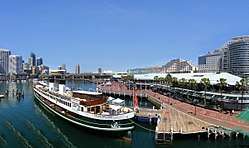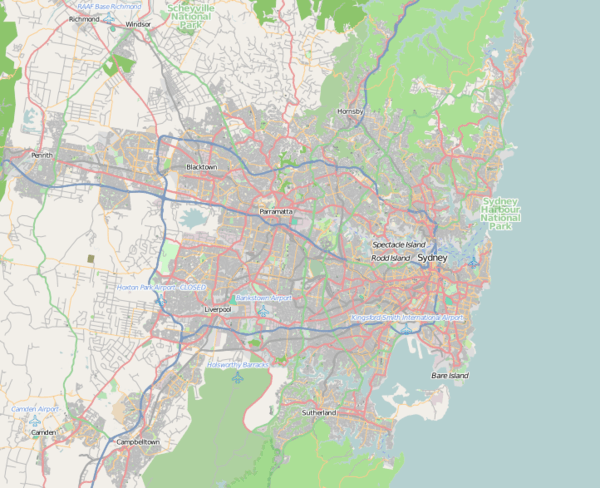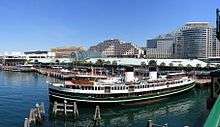SS South Steyne
 South Steyne being towed from Fleet Base East in June 2008 | |
| History | |
|---|---|
| Name: | SS South Steyne |
| Owner: | Port Jackson & Manly Steamship Company |
| Route: | Manly |
| Builder: | Henry Robb, Leith |
| Cost: | £141,526[1] |
| Yard number: | 267[2] |
| Launched: | 1 April 1938 |
| In service: | 24 October 1938 |
| Out of service: | August 1974 |
| Identification: |
|
| General characteristics | |
| Type: | double-ended, double-screw steamship ferry |
| Tonnage: | 1,203 GT |
| Length: | 70 m (230 ft) |
| Beam: | 11 m (36 ft) |
| Installed power: | 2,420 kW (3,250 hp) quadruple expansion steam engine |
| SS South Steyne | |
|---|---|
 South Steyne at its Harbourside berth in Darling Harbour. | |
| Location | Port Jackson, Sydney, New South Wales, Australia |
| Coordinates | 33°52′15″S 151°11′59″E / 33.8708°S 151.1997°ECoordinates: 33°52′15″S 151°11′59″E / 33.8708°S 151.1997°E |
| Built | 1937–1938 |
| Architect | Walter Leslie Dendy and John Ashcroft |
| Official name: South Steyne (S.S.); Manly Ferry; "SS South Steyne" | |
| Type | State heritage (movable / collection) |
| Designated | 2 April 1999 |
| Reference no. | 755 |
| Type | Vessel - harbour & river |
| Category | Transport - Water |
| Builders | Henry Robb Ltd |
 Location of SS South Steyne in Sydney | |
The SS South Steyne is an heritage-listed retired public steam ferry. For 36 years, she operated on the Manly run on Sydney Harbour and was the largest, steam-powered, passenger ferry in the world. Having more recently been used as a floating restaurant at Darling Harbour, since April 2016 she has been stored at Berrys Bay, in Sydney, New South Wales, Australia. She was designed by Walter Leslie Dendy and John Ashcroft and built from 1937 to 1938 by Henry Robb Ltd. She is also known as South Steyne (S.S.), Manly Ferry and "SS South Steyne"; and she was added to the New South Wales State Heritage Register on 2 April 1999.[4]
History

The Port Jackson and Manly Steamship Co. Ltd. was the best known of the Sydney ferry operators and was famous for the large and comfortable steamers which it ran to the seaside suburb and resort of Manly. The ferry service played a significant role in opening up settlement in that region from the 1850s. Patronage was growing steadily in the 1930s and the need to increase fleet capacity and the need for faster vessels led the Port Jackson Co. to order a new ferry boat.[4] In December 1936 the General Manager of the Port Jackson Co., Walter Leslie Dendy went to Britain to study sea transportation, propulsion techniques and to order a new ferry. By March 1937, seven shipbuilders had submitted tenders.
The contract was awarded to the Scottish shipbuilder Henry Robb Ltd. in Leith, Scotland for a steam reciprocating ship. The engine was built by Harland & Wolff Ltd., Belfast. The keel of the vessel was laid at Robb's Leith Yard in October 1937, and the SS South Steyne was launched on 1 April 1938. The name of the vessel came from the promenade behind the ocean beach at Manly.[4]
She set off on 7 July to steam the 22,000 kilometres (14,000 mi) to Australia where she arrived on 19 September.[5] The South Steyne was brought to Australia by Pedder and Mylchreest Ltd. of London and Captain R. M. Beedie was the master for the sixty-four day voyage. During the voyage, the South Steyne performed well and found no difficulty in the monsoonal conditions.[4] Beedie returned to England after the voyage. Also on the voyage was Captain A. E. Rowlings, who acted as first officer who went to England to take delivery of the vessel on behalf of the owner, and Captain C. Henderson, the second officer, who was reported by The Sydney Morning Herald to be a native of Manly.[6]
The South Steyne arrived in Sydney on 9 September 1938 and for the next 36 years gave faithful service on the Manly ferry run. The ferry had a justified reputation as a fine sea-going boat. For some 20 years she also ran Sunday ocean cruises to Broken Bay, north of Sydney and followed the Boxing Day yacht races to sea. It was the first Manly ferry to run day trips to the Pittwater area since the ferries Bingarra and HMAS Burra Bra were flagships of the Pittwater regatta in 1922 and 1928. The Broken Bay cruises lasted until the early 1970s. In 1964 the South Steyne collided with a freighter, the Jason and the ferry received bow damage on 29 September 1970 South Steyne collided with HMAS Melbourne while avoiding some racing yachts. Nobody was hurt and South Steyne again received minor damage to the bow.
The South Steyne was withdrawn from service in 1974 amid uncertainty about the future of the service. At that time it was the last steam ferry operating in Sydney. She was withdrawn from service as a commuter ferry when the government took up the option to purchase only Baragoola and North Head. Though still steam powered, South Steyne's boiler used three times the fuel of the diesel-electric powered ferries. On 25 August 1974, a week after the last run, a fire was deliberately lit in the forced draft fan room where three open drums of diesel were placed to accelerate the fire. The ferry's sprinkler system was sabotaged with a large screwdriver thrust into the little fuel tank supplying the diesel fire pump so it couldn't start. The fire severely damaged the fan room, middle stairway and promenade deckhouse above.If it hadn't been for the quick response of the Balmain fire brigade, the ferry would have been completely destroyed.[4][5]
A group of concerned Manly residents formed a preservation society in 1975 with the slogan "Save Our Steyne". They were able to prevent the ferry from being towed behind an old aircraft carrier, and scrapped in Hong Kong. The major damage in the fan room was repaired, new light fittings added to the promenade deck, the funnels and promenade deck sand blasted and the whole ferry was repainted. Negotiations with the Public Transport Commission took place to allow the ferry to run two return, peak-hour services to Manly, Monday to Friday. However, running the ferry was very political and restoration of the boilers was hampered by the surveyors from the Maritime Services Board. Lloyd's Register offered to hold the survey for the ferry but she was soon returned to the vendors because repayments were not made.
The South Steyne passed through a number of ownerships with intermittent conservation and restoration work being undertaken. Restoration work began in 1987 at Rileys Hill Dry Dock near Ballina and later in Melbourne.[5] In 1988 it was refitted as a cruising vessel/function centre and entered service in[Melbourne, its first function was as "Royal Yacht" for the Queen in April 1988. In 1991 it was sold to a Newcastle owner and was returned to NSW, initially to Newcastle, then to Sydney, where it was moored in Darling Harbour as the 2000 Olympic Information Centre at Darling Harbour.[4][7][8] She is once again a floating restaurant, next to Pyrmont Bridge, offering panoramic waterfront views of the Sydney skyline. In April 2016 it was temporarily relocated to Berrys Bay while the Darling Harbour wharf was rebuilt.[9][10]
The vessel's owner, Brian McDermott, has been funding repairs and maintenance from the restaurant's takings, but his business is on hold until NSW Roads & Maritime Services find a new berth.[4][11]
Service
The South Steyne was the largest ferry to operate on Sydney Harbour. As a Manly ferry from 1938, she crossed between Circular Quay and Manly over 100,000 times over her 36 years, carrying well in excess of 92 million passengers. On Sundays, from 1953 until 1973, she gave short ocean cruises to Broken Bay.[12]
Description
The South Steyne is a double-ended, double-screw steamship powered by a 2,420-kilowatt (3,250 hp) 4-cylinder quadruple expansion steam engine, manufactured by Harland & Wolff of Belfast. It was the largest ferry to operate on Sydney Harbour, designed and constructed to ocean-going ship standards. 1,203 tonnes (1,184 long tons; 1,326 short tons) gross, 67 metres (220 ft) in length and with a beam of 11 metres (36 ft). She has a double-ended riveted steel hull, steel superstructure to sun deck level, steel bulwarks, teak decks and wheelhouses, eight watertight bulk-heads, bar keel, double bottom under engine only. The steel superstructure rises to sun deck level, with teak decks and wheelhouses. Two funnels; one dummy containing water tank.[13][4][7]
Condition
As at 12 April 2000, the physical condition was good but with high level of maintenance required to retain this condition.[4]
This vessel was built to very high standards of structural strength and is in excellent condition, though requiring a constant high level of maintenance to maintain that condition. The hull, machinery and exterior generally in original condition. The open shelters at the ends of the promenade deck were enclosed and the interiors were significantly altered in the 1980s. Both reversible at some expense.[4]
Modifications and dates
The following modifications were made since her construction:[4]
- 1937 – keel laid
- 1 April 1938 – launched
- 9 September 1938 – arrived Sydney, registered
- 24 October 1938 – entered service
- 1944 – collision with Manly wharf
- 1953 – first ocean cruise
- 1964 – alterations to passenger accommodation
- 1972 – last ocean cruise
- August 1974 – withdrawn from service. Fire damaged
- 1975 – sold out of service
- 1988 – refit as restaurant/cruising vessel
Further information
Location movable. Located Port Hunter when PCO was made; now Port Jackson. Now an extremely rare item in international terms - largest surviving operating example of this significant maritime technology. Needs careful on-going management strategy, and ultimately probable state support or ownership.[4]
Heritage listing
As at 18 February 1999, The South Steyne was the best known of the Manly ferry line which played a major role in the suburbanisation of Sydney and in the development of its recreational patterns. It is a very high quality example of naval architecture and an outstanding example of the plating (having no flat plates) for which Henry Robb of Leith was famous. It is the finest example of the most significant Australian contribution to sea navigation technology - the development of high speed, double-ended operation in deep sea conditions. It has an intact operating example of propulsion by steam reciprocating engine. It epitomised the Manly ferry as part of Sydney's image and its popular urban culture; and remains, like the Harbour Bridge, a powerful piece of Sydney imagery. It is held in high esteem by the local community and remains in the collective memory of the nation. It provides a working example of the propulsion and auxiliary functions of marine steam power.[4][7]
SS South Steyne was listed on the New South Wales State Heritage Register on 2 April 1999 having satisfied the following criteria.[4]
The place is important in demonstrating the course, or pattern, of cultural or natural history in New South Wales.
The South Steyne was the best known of the Manly ferry line which played a major role in the suburbanisation of Sydney and the development of its recreational patterns. It symbolises the progressive approach of the Board of the Port Jackson and Manly Steamship Company and, in particular, the creative ingenuity of the General Manager, Walter Leslie Dendy, who assisted design of the vessel and created much of the image for which the Manly ferry was famous in the twentieth century. It is associated with the development and culture of Manly and Warringah as a residential and recreational area.[7][4]
The place is important in demonstrating aesthetic characteristics and/or a high degree of creative or technical achievement in New South Wales.
It is a very high quality example of naval architecture and an outstanding example of the plating (having no flat plates) for which Henry Robb of Leith was famous. It is the finest example of the most significant Australian contribution to sea navigation technology - the development of high speed double-ended operation in deep sea conditions. It has an intact operating example of propulsion by steam reciprocating engine.[7][4]
The place is ihas strong or special association with a particular community or cultural group in New South Wales for social, cultural or spiritual reasons.
It epitomised the Manly ferry as part of Sydney's image and its popular urban culture; it remains, like the Harbour Bridge, a powerful piece of Sydney imagery. It has featured in Sydney poster-art for over 50 years. It is held in high esteem by the local community and remains in the collective memory of the nation.[7][4]
The place has potential to yield information that will contribute to an understanding of the cultural or natural history of New South Wales.
It provides a working example of the propulsion and auxiliary functions of marine steam power.[7][4]
The place possesses uncommon, rare or endangered aspects of the cultural or natural history of New South Wales.
It is one of three Manly ferries of the Port Jackson and Manly Steamship Company surviving afloat and the only one in operating condition and the only steam-powered example. It is rare evidence of the large ferry systems which stimulated the growth of suburban Sydney. It is uniquely Australian in concept and design. It has the largest and most powerful operating marine reciprocating steam engine surviving in the world today (including original Scotch boilers and auxiliaries), providing rare international evidence of the machinery that powered the Industrial Revolution at sea.[7][4]
The place is important in demonstrating the principal characteristics of a class of cultural or natural places/environments in New South Wales.
It is representative of twentieth-century Manly ferries and is the optimal development of the steam-propelled Manly ferry.[7][4]
See also
References
- ↑ Andrew, Graeme (994). Ferries of Sydney (3rd ed.). Sydney University Press.
- ↑ "Ship No 267". Leith Built Ships. Retrieved 27 June 2010.
- ↑ "South Steyne IMO: 5335151". Shipspotting. Retrieved 27 June 2010.
- 1 2 3 4 5 6 7 8 9 10 11 12 13 14 15 16 17 18 19 20 "South Steyne (S.S.), New South Wales State Heritage Register (NSW SHR) Number H00755". New South Wales State Heritage Register. Office of Environment and Heritage. Retrieved 2 June 2018.
- 1 2 3 "South Steyne (S.S.)". Maritime heritage. NSW Office of Environment and Heritage. Retrieved 21 July 2013.
- ↑ "New Ferry for Manly Run". The Sydney Morning Herald. 10 September 1938. p. 12. Retrieved 10 September 2015 – via National Library of Australia.
- 1 2 3 4 5 6 7 8 9 Heritage Branch 1992
- ↑ Prescott, A.; Willson, R.; Plowman, P. (1990). 'South Steyne'. Australian Sea Heritage.
- ↑ Home South Steyne
- ↑ "South Steyne's rivals left floundering in the wake of her prestige". Manly Daily. 18 February 2017.
- ↑ Ticha, Victora (13 December 2016). "Heritage Listed South Steyne waits for a berth to call home". The Sydney Morning Herald. p. 9.
- ↑ "Remember the South Steyne..." South Steyne. Retrieved 27 June 2010.
- ↑ I Brady 1976
Bibliography
- Prescott, A.; Willson, R.; Plowman, P. (1990). 'South Steyne'. Australian Sea Heritage.
- Attraction Homepage (2007). "South Steyne (S.S.)".
- Prescott, A. (1992). Former Manly Ferry South Steyne Proposed Permanent Conservation Order. Branch Managers Report to the Heritage Council.
Attribution
![]()
External links
![]()